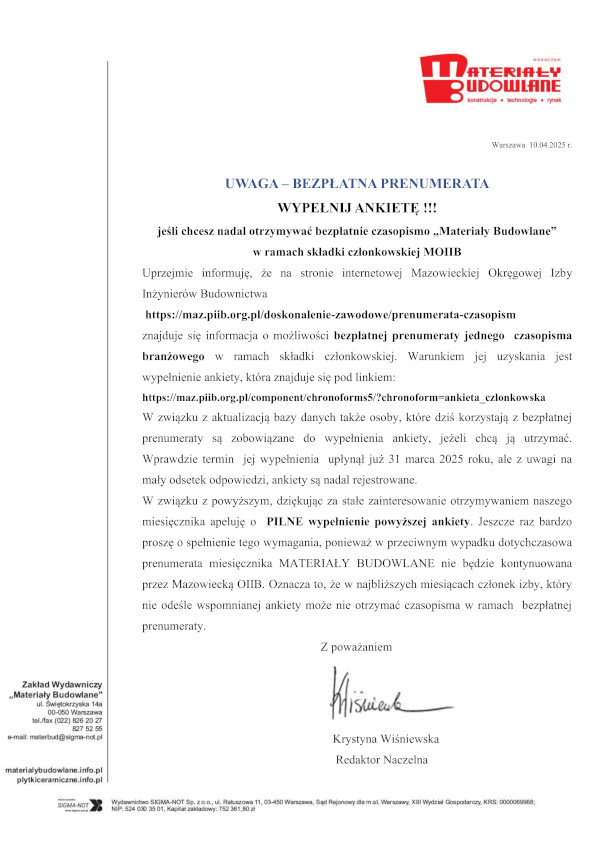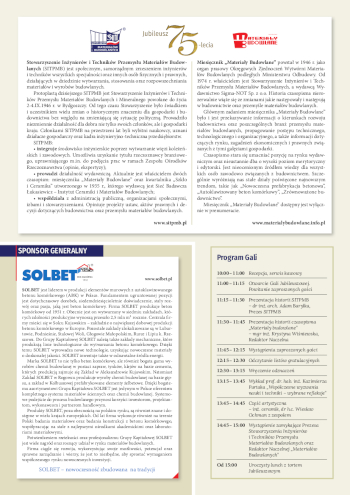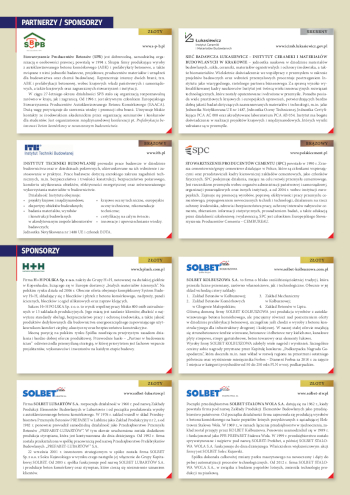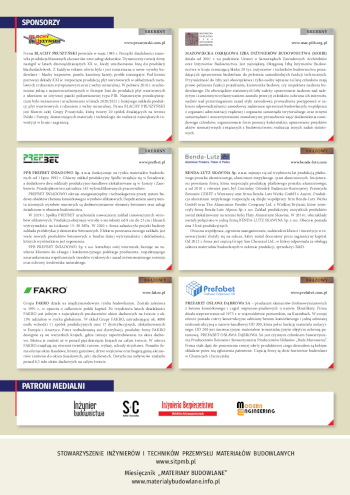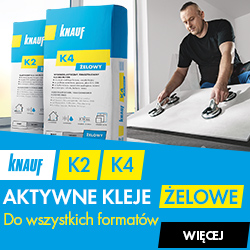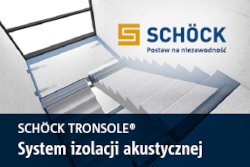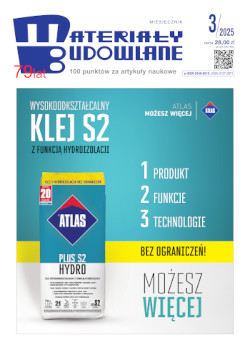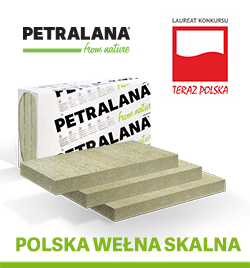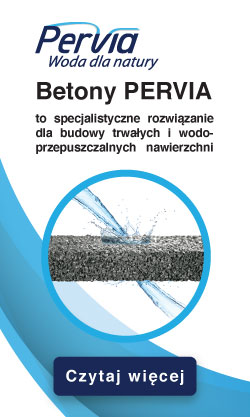Badanie zachowania styropianu EPS przy ściskaniu w świetle zapisów normy oraz literatury przedmiotu
Open Access (Artykuł w pliku PDF)
citation/cytuj: Słowiński K. Studies on the behaviour of EPS polystyrene under compression in the light of standard provisions and subject literature. Materiały Budowlane. 2025. Volume 632. Issue 04. Pages 63-69. DOI: 10.15199/33.2025.04.09
dr inż. Kamil Słowiński, Politechnika Śląska, Wydział Budownictwa
ORCID: 0000-0002-4225-520X
Correspondence address: Ten adres pocztowy jest chroniony przed spamowaniem. Aby go zobaczyć, konieczne jest włączenie w przeglądarce obsługi JavaScript.
DOI: 10.15199/33.2025.04.09
Review paper / Artykuł przeglądowy
Abstract. The article discusses selected provisions of the PN-EN ISO 29469:2023-05 standard regarding the testing methodology and the method of assessing the results of the EPS polystyrene compression test, in the context of the preparation of test elements, the testing procedure and assessment of the results of the EPS polystyrene compression test and the possible possibility of structural use of thismaterial. The provisions of the standard are discussed against the background of research results presented in the literature on the subject and the author's own research.The need to supplement the standard provisions is indicated.
Keywords: EPS polystyrene; compressive strength; modulus of elasticity.
Streszczenie. W artykule omówiono wybrane zapisy normy PN-EN ISO 29469:2023-05 dotyczące metody badań i sposobu oceny wyników próby ściskania polistyrenu EPS, w kontekście przygotowania elementów próbnych, procedury badań i oceny wyników próby ściskania polistyrenu EPS oraz ewentualnej możliwości konstrukcyjnego wykorzystania tego materiału. Zapisy normy omówiono na tle rezultatów badań przedstawionych w literaturze przedmiotu oraz badań własnych. Wskazano przy tym na konieczność uzupełnienia zapisów normowych.
Słowa kluczowe: styropian EPS; polistyren; wytrzymałość na ściskanie; moduł sprężystości.
Literature
[1] PN-EN ISO 29469:2023-05 Wyroby do izolacji cieplnej w budownictwie. Określanie zachowania przy ściskaniu.
[2] PN-EN 14933 Lekkie wyroby wypełniające i izolacyjne do zastosowań w budownictwie lądowym i wodnym. Wyroby ze styropianu (EPS) produkowane fabrycznie. Specyfikacja.
[3] Stark TD, Arellano D, Leshchinsky D, Horvath J. Geofoam Applications in the Design and Construction of Highway Embankments. 2004. Available: www.TRB.org.
[4] Deshmukh R, Iyer S, Bhangare P. Geotechnical characterization of Expanded polystyrene (EPS) beads with industrial waste and its utilization in flexible pavement. Mater Today Proc. 2022. DOI: 10.1016/j.matpr.2021.07.462.
[5] PN-EN 14509:2013-12 Samonośne izolacyjno-konstrukcyjne płyty warstwowe z dwustronną okładziną metalową. Wyroby fabryczne. Specyfikacje.
[6] https://www. inwestycje. plus/nowoczesne-budownictwo-na-miare-wymagan- transformacji-energetycznej-budownictwo-zeroemisyjne/.
[7] PN-EN 13163+A2:2016-12 Wyroby do izolacji cieplnej w budownictwie. Wyroby ze styropianu (EPS) produkowane fabrycznie. Specyfikacja.
[8] PN-EN 1607:2013-07 Wyroby do izolacji cieplnej w budownictwie. Określanie wytrzymałości na rozciąganie prostopadle do powierzchni czołowych.
[9] PN-EN 12089:2013-07 Wyroby do izolacji cieplnej w budownictwie. Określanie zachowania przy zginaniu.
[10] PN-EN 12090:2013-07 Wyroby do izolacji cieplnej w budownictwie – Określanie zachowania przy ścinaniu.
[11] PN-EN ISO 16534: 2020-12 Wyroby do izolacji cieplnej w budownictwie. Określanie pełzania przy ściskaniu.
[12] https://termoorganika. pl/produkt/setka-podloga-eps-100.
[13] Chun BS, Lim HS, Sagong M, Kim K. Development of a hyperbolic constitutivemodel for expanded polystyrene (EPS) geofoamunder triaxial compression tests. Geotextiles andGeomembranes. 2004.DOI: 10.1016/j. geotexmem.2004.03.005.
[14] Solomon A., Hemalatha G. Characteristics of expanded polystyrene (EPS) and its impact on mechanical and thermal performance of insulated concrete form (ICF) system. Structures. 2020. DOI: 10.1016/j. istruc. 2019.10.019.
[15] Smakosz Ł, Tejchman J. Evaluation of strength, deformability and failure mode of composite structural insulated panels. Mater Des. 2014. DOI: 10.1016/j. matdes. 2013.09.032.
[16] Chen W, Hao H, Hughes D, Shi Y, Cui J, Li Z. X. Static and dynamic mechanical properties of expanded polystyrene.Mater Des. 2015. DOIi: 10.1016/j. matdes. 2014.12.024.
[17] Abdelrahman GE, Tatsuoka F. Small strain-stress properties of expanded polystyrene geofoam. Soils and Foundations. 2008; vol. 48, pp. 61–71.
[18] Vaitkus S, Vėjelis S, Šeputytė-Jucikė J, Członka S, Strzelec K, Kairytė A. Analysis of Active and Passive Deformation of Expanded Polystyrene Foam under Short-Term Compression. Materials. 2022. DOI: 10.3390/ma15217548.
[19] Eriksson L., Trank R. Properties of expanded polystyrene – Laboratory experiments. Stockholm, 1991.
[20] Duŝkov M. Materials Research on EPS20 and EPS15 Under Representative Conditions in Pavement Structures. Geotextiles and Geomembranes. 1997. DOI. org/10.1016/S0266-1144 (97) 00011-3.
[21] Di Landro L, Sala G, Olivieri D. Deformation mechanisms and energy absorption of polystyrene foams for protective helmets. Polym Tes. 2002. DOI: 10.1016/S0142-9418 (01) 00073-3.
[22] Hazarika H. Stress-strainmodeling of EPS geo foam for large-strain applications. Geotextiles and Geomem branes. 200.DOI: 10.1016/j.geotexmem.2005.11.003.
[23] Avalle M, Belingardi G, Ibba A. Mechanical models of cellular solids: Parameters identification from experimental tests. Int J Impact Eng. 2007. DOI: 10.1016/j. ijimpeng. 2006.06.012.
[24] Horvath J. S. The Compressible Inclusion Function of EPS Geofoam. Geotextiles and Geomembranes. 1997. DOI: org/10.1016/S0266-1144 (97) 00008-3.
[25] ByS. Manual for Expanded Polystyrene (EPS) Core Panel Systemand its field Application Ministry of Housing and Urban Poverty Alleviation. GovernmentofIndia.2017.
Received: 09.12.2024 / Artykuł wpłynął do redakcji: 09.12.2024 r.
Revised: 07.01.2025 / Otrzymano poprawiony po recenzjach: 07.01.2025 r.
Published: 25.04.2025 / Opublikowano: 25.04.2025 r
Materiały Budowlane 04/2025, strona 63-69 (spis treści >>)


